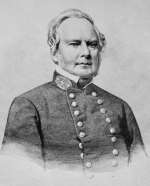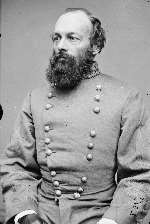Search:
Powered by
Website Baker
Prologue
The confrontation at Westport was the result of a three-year long quest by Missouri Confederates to take their state back from the Federal occupying forces. In 1861, Missouri’s government had been driven into exile by the Federals. Then the Missouri State Convention had vacated the office of Governor, both houses of the General Assembly, and installed a Provisional Governor. Missouri Confederates believed the Provisional State Government was illegitimate, propped up by the Federal army occupying the state.
 Sterling Price courtesy of the Library of Congress |
Sterling Price wanted to lead once last attempt to reclaim Missouri for the Confederacy. A Virginia native, Price had moved in 1831 to Chariton County, Missouri and became a prominent tobacco planter and slave owner. He then entered politics, serving in the Missouri General Assembly and representing Missouri in Congress. When the war with Mexico began, Price raised a regiment of volunteers from Missouri. Returning to Missouri after the war ended, Price ran for and was elected Governor of the state, serving one term from 1853-1857. In March 1861, Price was even President of the Missouri State Convention that voted not to secede from the Union. But when war broke out, Price decided to stand by the South, writing of his decision in a letter to a friend.
"It is now inevitable that the general government will attempt the coercion of the southern states. War will ensue. I am a military man, a southern man, and if we have to fight, will do so on the part of the South."
It was now 1864 and Sterling Price was a major general in the Confederate States Army in command of the District Arkansas. He had been fighting the Federal usurpers for three years. Once again, Price believed it was time to re-enter Missouri. Price said so in a July 23 letter to his commanding officer, Lieutenant General Kirby Smith.
"The accumulating testimony of the state of affairs in Missouri … show that the Federals have but few reliable forces in the State, their garrisons being manned almost entirely with their State militia, in whose loyalty they have but little confidence … I am also assured that the Confederate flag floats over nearly all the principal towns of North Missouri, and large guerrilla parties are formed and operating in the southern portion of the State … I respectfully but urgently suggest the propriety of making a move into the State."
 Kirby Smith courtesy of the Library of Congress |
On August 4, Sterling Price received his marching orders from General Kirby Smith.
"You will make immediate arrangements for a movement into Missouri, with the entire cavalry force of your district … You will scrupulously avoid all wanton acts of destruction and devastation, restrain your men, and impress upon them that their aim should be to secure success in a just and holy cause and not to gratify personal feeling and revenge. Rally the loyal men of Missouri, and remember that our great want is men, and that your object should be, if you cannot maintain yourself in that country, to bring as large an accession as possible to our force … Make Saint Louis the objective point of your movement, which, if rapidly made, will put you in possession of that place, its supplies, and military stores, and which will do more toward rallying Missouri to your standard than the possession of any other point. Should you be compelled to withdraw from the State, make your retreat through Kansas and the Indian Territory, sweeping that country of its mules, horses, cattle, and military supplies of all kinds."
Price began preparing marshalling his forces for an invasion of Missouri. But it was the middle of September before Price was able to start heading for that state.